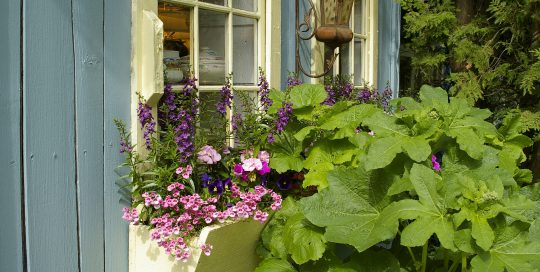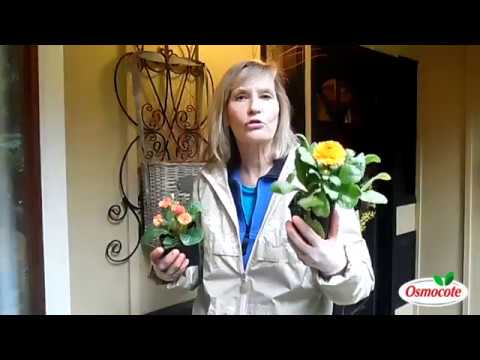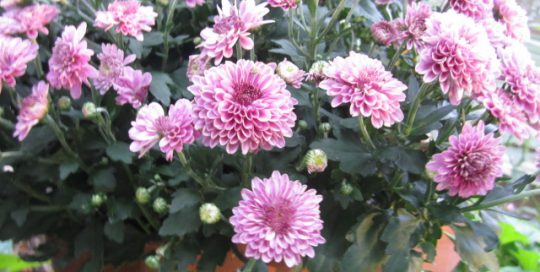It takes restraint to devote one container to one plant. In my case, it would also require lots and lots of containers. By late August, though, it’s the one-pot-one-plant configuration that that requires the least attention. The majority of the pots I use for plant combos are some of the largest I can find. They’re at least 22 to 24 inches in diameter and just as deep. They are my opportunity to grow as many varieties as I like right on my overcrowded patio.
But this is the time of year when they require lots of attention to watering, feeding, and pruning. I don’t want lots of one-plant containers. It’s been happening slowly since the pot’s roots filled out. The stems of its residents have puffed up to their full size. They’ve reached critical mass. If you haven’t been doing gradual maintenance pruning, now is the time to trim back the space invaders and rescue the shrinking violets.
In early summer, when I plant each container, I go for a full look right away. Which is why I jam each resident into the pot like sardines in a can. By now, though, it’s clear which ones should have given lodgings elsewhere. Just a few that should live alone include Hibiscus ‘Mahogany Splendor’, Digitalis ‘Silver Fox’, coleus ‘Campfire’, Colocasia esculenta ‘Illustris’, ribbon bush (Homalocladium platycladium), and Peruvian daffodil (Ismene ‘Sulphur Queen’).
I’ll take it a container at a time, naming the pot-mates in each.
Container 1
I combined Hibiscus ‘Mahagony Splendor’ with coleus ‘Fishnet Stockings’ (a bruiser in its own right) because the stripes on the leaves of the coleus matched perfectly with the leaf color of the Hibiscus. I failed to take into account the plants’ shapes—both upright and branching as they grew taller in the pot. The Hibiscus proved to be stronger, setting the coleus into a precarious tilt that caused it to lose its charm. Also in the container were superbells (Calibrachoa) ‘Double Ruby’ and Euphorbia ‘Diamond Frost’, both of which were spared the aggressiveness of the Hibiscus by virtue of their trailing habits. Removing the bottom stems of the Hibiscus helped keep the trailers happy.
Container 2
A much smaller container (12-inches in diameter) combines foxglove (Digitalis) ‘Silver Fox’, tuberose (Polianthes tuberosa) ‘Pink Sapphire’, and pink rain lily (Zephyranthes robusta). Although each of the trio is holding its own even this late in the season, the pot must be watered at least once a day because it’s so full of roots. The burliest of the three is the foxglove. Digitalis ‘Silver Fox’ deserves its own pot. However, when I planned the combination, I envisioned its fuzzy silver leaves playing off the deep pink of the rain lily and pale pink of the tuberose. I’ve been removing entire branches of the foxglove to keep it from encroaching on its pot-mates.
Container 3
I’m not sure whether the biggest bully in a 24-inch container is coleus ‘Campfire’ or the Peruvian daffodil (Ismene) ‘Sulphur Queen’. Flanked on both sides by two plants of coleus, the Ismene is holding its own. ‘Sulphur Queen’ has already bloomed and has formed lots of healthy green leaves that feed the bulbs for next year. The textural mediator that’s preventing a death match is Alocasia gagaena ‘California’, a variety of elephant ear that is considered a dwarf at just four feet tall. I’d combined the bright green Alocasia and the yellow-flowered Ismene to brighten up the deep copper color of the coleus.
But I didn’t stop there. I plugged in the variegated green and cream leaf geranium (Pelargonium) ‘Petals’, a shrimp plant Justicia brangeana, and a gold-leaved shamrock Oxalis ‘Molten Lava’. If I had it to over, I’d leave the Ismene in a large pot of its own and enjoy the remaining plants, minus one of the coleus.
Container 4
Under the heading: “What Was I Thinking” comes the round bowl with the mums. I received three plants each of a Dendranthema (Yes, they’re no longer called Chrysanthemums) ‘Harvest Igloo’ to try in my garden. They were tiny in May, so I tucked them into the 12-inch diameter planter. I was picturing a beautifully rounded bowl of copper-colored flowers by late September. What I have now is a bowl of yellowed leaves on stems topped with pretty healthy foliage. The downside is that it needs to be watered twice a day. The plants are said to grow just 18-inches tall. However, if I’d paid attention to their spread (25” to 30”), I’d have known it was a bad idea. The only thing I can do now is to plant them in the ground so their roots will have some breathing room.
Container 5
There are hundreds of species and varieties of plants known as elephant ears, a common name that should be a caution in itself. So when I planted Colocasia esculenta ‘Illustris’ in a pot with leopard plant Farfugium japonicum and Coreopsis Sizzle & Spice ‘Curry Up’, I couldn’t claim I wasn’t warned. But the potential impact made by the elephant ear’s deep black-green color, the leopard plant’s forest green leaves spotted with bright yellow, and the gold flowers of the Coreopsis was too much of a temptation. The trio is getting along well, but the Coreopsis is getting short changed by virtue of the two plants’ heavy-handedness. Also, the elephant ear and leopard plant both prefer a part sun location, while the Coreopsis likes as much sun as it can get.
Container 6
I’d never grown ribbon bush (Homalocladium platycladium) before. I could tell from the way it filled out its pot at the garden center that it was going to be large. So I combined it in my biggest pot with others that I thought would enjoy its company. At the beginning, African daisy (Osteospermum) ‘Bright Lights Double Moonglow’ was the frontrunner for queen of the vigorous. Its many stems offered constant bud and blooms of a soft cream with lemon-yellow centers. A bit on the rangy side, it nevertheless provided color for at least two months before succumbing to the heat. I’ve cut it back and it’s once again promising to return to its full glory.
I also preemptively pruned the ribbon bush when I realized it was horning in on its neighbors. These consisted of Salvia ‘Playin’ the Blues’, and variegated tapioca (Manihot esculenta) ‘Variegata’. The tapioca neither faded nor flourished. It provided some green-gold-red accent, while the Salvia grew well past the others and into a giant hummingbird magnet. It’s even giving the gold edge sky flower (Duranta erecta ‘Gold Edge’) a run for its money. Although, this tropical shrub is looking very promising and might even bloom soon.
Gardening Lessons
Some of the containers listed also have other plants in them that didn’t fare as well in their roles as companions to their robust companions. They’re not bad plants. And I shouldn’t even be calling them delicate. Their disappearance by virtue of their companions’ beefy character was by no measure their fault. Gardening is a learning experience, and the lessons I came away with include:
- Check plant tags for spread as well as height.
- Mixing a potentially burly plant with a less substantial one might work if the weaker plant has a head start, or has grown to a larger size than the stronger plant.
- Dig up some saucers to put beneath pots that dry out quickly. It’s a no-no early in the year, but is key to avoid being a hose slave for the rest of the season.
- Avoid combining two upright growers in the same pot.
- Never underestimate a plant’s potential size.
- It’s better to prune preemptively if you must than give a plant a “bad haircut” in an emergency situation.









